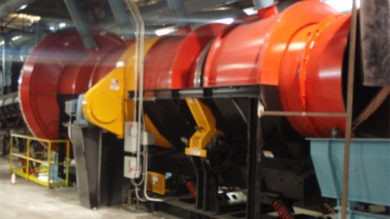When it comes to choosing the optimal drum technology for your foundry, there are two basic options available: vibratory drums and rotary drums. Both technologies offer advantages in certain applications, so what factors should you consider in determining the best solution for your process?
Vibratory Drums
Vibratory drums come in two varieties: media and non-media applications. Vibratory drums are optimal for no-bake, brass, and all other foundry applications where the reduction or elimination of casting damage is necessary. Benefits of the non-rotating design include ease of dust collection and air system attachments, the ability to add peripheral attachments such as water addition, and formatting auxiliary equipment to the drum.
Non-media vibrating drums such as General Kinematics VIBRA-DRUM® Sand Casting Conditioner, deliver high capacity throughput, plus superior material motion, for efficient sand and casting processing. The VIBRA-DRUM® uses a natural frequency vibration that produces a beneficial drum-like rotary motion of the sand and casting bed that quickly reduces sand lumps and cleans surface sand from castings without causing the castings to fall and tumble on each other. This motion reduces the chance of damage to fragile castings such as motor housings and camshafts, which would nick, chip, or crack when processed through a rotary drum. The castings and sand are typically discharged onto a Two-Mass, high-frequency vibratory shakeout, which imparts high energy at a small stroke to remove mold and any remaining core sand from the castings.
General Kinematics VIBRA-CLEAN™ Vibratory Media Drum cleans and cools castings in one efficient step. The VIBRA-CLEAN™ can use any type of media, which optimizes cleaning operations based on desired results for your particular casting. Molds are processed over a vibratory shakeout prior to entering the Vibra-Clean to remove mold sand. Once inside, they are conveyed in a horizontal path, eliminating casting to casting contact. The media is activated in a circular motion within the drum, gently scrubbing castings clean. This motion eliminates media from wedging or jamming into casting surfaces, which is a problem typically found when rotary media drums are used. This motion also eliminates labor and casting inspection time post cleaning. The castings and media then exit the drum onto a vibratory conveyor, where media is screened from the castings, and recirculated.
Rotary Drums
Rotary drums have been used for many years as a simple, cost-effective solution for processing castings in all types of foundries. However, rotary drums tend to lift and drop castings, which can cause unnecessary damage and increased scrap rates. One place that rotary drums still have applicability is in the ductile foundry, where gates, runners and sprue need to be removed from castings prior to blast. Due to the
lift and drop action of rotary devices, tangling of castings and sprue is also reduced.
Innovations in rotary technology, such as General Kinematics DUCTA-SERIES™ Rotary Drums, allow ductile foundries to effectively process castings without the typical high maintenance costs found in older rotary technology. Drums in the DUCTA-SERIES™ line use a single segmented heavy-duty rotary shell. This significantly reduces the maintenance costs of replacing expensive cast liners found in other types of rotary drums and allows only portions of the drum shell to be replaced as needed. Patent pending DUCTA-SERIES™ drums extract sand and media through multiple discharge points within the drum. Use of vibratory collection technology allows the foundry to direct the sand in any direction the foundry chooses for optimal process layout and eliminates reintroduction of sand to the drum for optimal process tuning.
Rotary drums are designed to perform specific processes. Drums such as the DUCTA-SPRUE® Rotary Sprue Drum are specifically engineered to quickly clean and break up sprue for cleaner recycling. The DUCTA-SCREEN™ Rotary Shakeout removes sand from castings and removes sprue and gates from castings. The DUCTA-CLEAN® Rotary Media Drum uses media to clean ductile castings prior to the blast process.
Foundry drums offer many benefits to innovate foundry operations. Whether you cast delicate motor housings or large ductile castings, drum technology exists to increase your foundry throughput, produce cleaner castings for finishing, and reduce emissions. For more information, or help selecting a drum, contact GK Foundry Experts.






